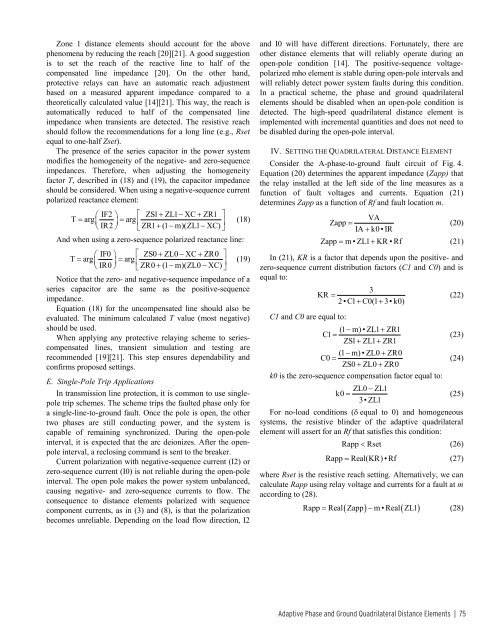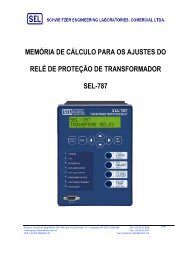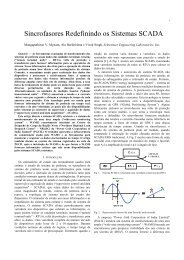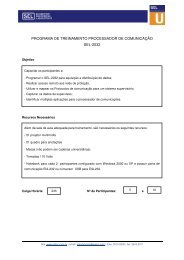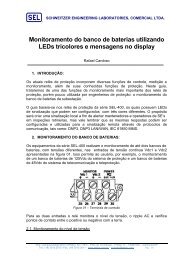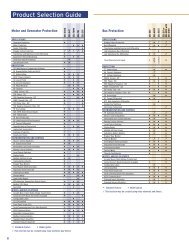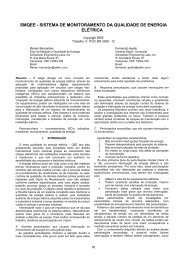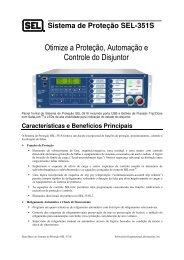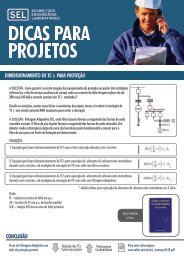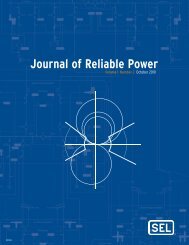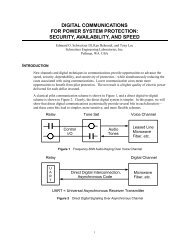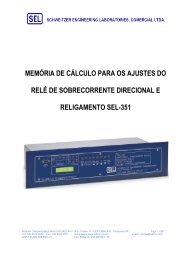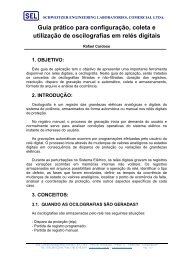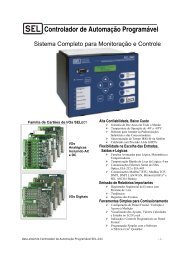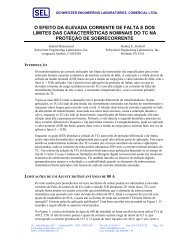Journal of Reliable Power - SEL
Journal of Reliable Power - SEL
Journal of Reliable Power - SEL
Create successful ePaper yourself
Turn your PDF publications into a flip-book with our unique Google optimized e-Paper software.
11<br />
Zone 1 distance elements should account for the above<br />
phenomena by reducing the reach [20][21]. A good suggestion<br />
is to set the reach <strong>of</strong> the reactive line to half <strong>of</strong> the<br />
compensated line impedance [20]. On the other hand,<br />
protective relays can have an automatic reach adjustment<br />
based on a measured apparent impedance compared to a<br />
theoretically calculated value [14][21]. This way, the reach is<br />
automatically reduced to half <strong>of</strong> the compensated line<br />
impedance when transients are detected. The resistive reach<br />
should follow the recommendations for a long line (e.g., Rset<br />
equal to one-half Zset).<br />
The presence <strong>of</strong> the series capacitor in the power system<br />
modifies the homogeneity <strong>of</strong> the negative- and zero-sequence<br />
impedances. Therefore, when adjusting the homogeneity<br />
factor T, described in (18) and (19), the capacitor impedance<br />
should be considered. When using a negative-sequence current<br />
polarized reactance element:<br />
⎛ IF2 ⎞ ⎡ ZS1 + ZL1 − XC + ZR1 ⎤<br />
T = arg⎜ ⎟ = arg<br />
IR2<br />
⎢<br />
ZR1 + (1 − m)(ZL1 − XC)<br />
⎥ (18)<br />
⎝ ⎠ ⎣ ⎦<br />
And when using a zero-sequence polarized reactance line:<br />
⎛ IF0 ⎞ ⎡ ZS0 + ZL0 − XC + ZR0 ⎤<br />
T = arg ⎜ ⎟ = arg<br />
IR0<br />
⎢<br />
ZR0 + (1 − m)(ZL0 − XC)<br />
⎥ (19)<br />
⎝ ⎠ ⎣ ⎦<br />
Notice that the zero- and negative-sequence impedance <strong>of</strong> a<br />
series capacitor are the same as the positive-sequence<br />
impedance.<br />
Equation (18) for the uncompensated line should also be<br />
evaluated. The minimum calculated T value (most negative)<br />
should be used.<br />
When applying any protective relaying scheme to seriescompensated<br />
lines, transient simulation and testing are<br />
recommended [19][21]. This step ensures dependability and<br />
confirms proposed settings.<br />
E. Single-Pole Trip Applications<br />
In transmission line protection, it is common to use singlepole<br />
trip schemes. The scheme trips the faulted phase only for<br />
a single-line-to-ground fault. Once the pole is open, the other<br />
two phases are still conducting power, and the system is<br />
capable <strong>of</strong> remaining synchronized. During the open-pole<br />
interval, it is expected that the arc deionizes. After the openpole<br />
interval, a reclosing command is sent to the breaker.<br />
Current polarization with negative-sequence current (I2) or<br />
zero-sequence current (I0) is not reliable during the open-pole<br />
interval. The open pole makes the power system unbalanced,<br />
causing negative- and zero-sequence currents to flow. The<br />
consequence to distance elements polarized with sequence<br />
component currents, as in (3) and (8), is that the polarization<br />
becomes unreliable. Depending on the load flow direction, I2<br />
and I0 will have different directions. Fortunately, there are<br />
other distance elements that will reliably operate during an<br />
open-pole condition [14]. The positive-sequence voltagepolarized<br />
mho element is stable during open-pole intervals and<br />
will reliably detect power system faults during this condition.<br />
In a practical scheme, the phase and ground quadrilateral<br />
elements should be disabled when an open-pole condition is<br />
detected. The high-speed quadrilateral distance element is<br />
implemented with incremental quantities and does not need to<br />
be disabled during the open-pole interval.<br />
IV. SETTING THE QUADRILATERAL DISTANCE ELEMENT<br />
Consider the A-phase-to-ground fault circuit <strong>of</strong> Fig. 4.<br />
Equation (20) determines the apparent impedance (Zapp) that<br />
the relay installed at the left side <strong>of</strong> the line measures as a<br />
function <strong>of</strong> fault voltages and currents. Equation (21)<br />
determines Zapp as a function <strong>of</strong> Rf and fault location m.<br />
VA<br />
Zapp =<br />
IA + k0 • IR<br />
(20)<br />
Zapp = m • ZL1 + KR • Rf<br />
(21)<br />
In (21), KR is a factor that depends upon the positive- and<br />
zero-sequence current distribution factors (C1 and C0) and is<br />
equal to:<br />
KR 3<br />
=<br />
(22)<br />
2 • C1 + C0(1 + 3• k0)<br />
C1 and C0 are equal to:<br />
(1 − m) • ZL1 + ZR1<br />
C1 =<br />
(23)<br />
ZS1 + ZL1 + ZR1<br />
(1 − m) • ZL0 + ZR0<br />
C0 =<br />
(24)<br />
ZS0 + ZL0 + ZR0<br />
k0 is the zero-sequence compensation factor equal to:<br />
ZL0 − ZL1<br />
k0 = (25)<br />
3• ZL1<br />
For no-load conditions (δ equal to 0) and homogeneous<br />
systems, the resistive blinder <strong>of</strong> the adaptive quadrilateral<br />
element will assert for an Rf that satisfies this condition:<br />
Rapp < Rset<br />
(26)<br />
Rapp = Real(KR) • Rf<br />
(27)<br />
where Rset is the resistive reach setting. Alternatively, we can<br />
calculate Rapp using relay voltage and currents for a fault at m<br />
according to (28).<br />
Rapp = Real( Zapp) − m • Real( ZL1)<br />
(28)<br />
Adaptive Phase and Ground Quadrilateral Distance Elements | 75


